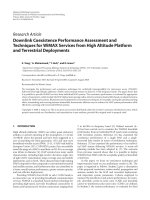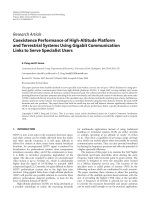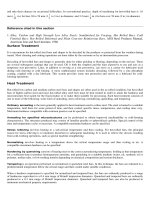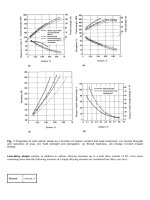High performance materials and engineered chemistry
Bạn đang xem bản rút gọn của tài liệu. Xem và tải ngay bản đầy đủ của tài liệu tại đây (9.04 MB, 419 trang )
www.pdfgrip.com
HIGH-PERFORMANCE MATERIALS
AND ENGINEERED CHEMISTRY
www.pdfgrip.com
www.pdfgrip.com
Innovations in Physical Chemistry: Monograph Series
HIGH-PERFORMANCE MATERIALS
AND ENGINEERED CHEMISTRY
Edited by
Francisco Torrens, PhD
Devrim Balköse, PhD
Sabu Thomas, PhD
www.pdfgrip.com
Apple Academic Press Inc.
Apple Academic Press Inc.
3333 Mistwell Crescent
9 Spinnaker Way
Oakville, ON L6L 0A2
Waretown, NJ 08758
CanadaUSA
© 2018 by Apple Academic Press, Inc.
No claim to original U.S. Government works
Printed in the United States of America on acid-free paper
International Standard Book Number-13: 978-1-77188-598-0 (Hardcover)
International Standard Book Number-13: 978-1-315-18786-0 (eBook)
All rights reserved. No part of this work may be reprinted or reproduced or utilized in any form or by any
electronic, mechanical or other means, now known or hereafter invented, including photocopying and recording, or in any information storage or retrieval system, without permission in writing from the publisher
or its distributor, except in the case of brief excerpts or quotations for use in reviews or critical articles.
This book contains information obtained from authentic and highly regarded sources. Reprinted material is
quoted with permission and sources are indicated. Copyright for individual articles remains with the authors
as indicated. A wide variety of references are listed. Reasonable efforts have been made to publish reliable
data and information, but the authors, editors, and the publisher cannot assume responsibility for the validity
of all materials or the consequences of their use. The authors, editors, and the publisher have attempted to
trace the copyright holders of all material reproduced in this publication and apologize to copyright holders
if permission to publish in this form has not been obtained. If any copyright material has not been acknowledged, please write and let us know so we may rectify in any future reprint.
Library of Congress Control Number: 2017953051
Trademark Notice: Registered trademark of products or corporate names are used only for explanation
and identification without intent to infringe.
Library and Archives Canada Cataloguing in Publication
High-performance materials and engineered chemistry / edited by Francisco Torrens, PhD,
Devrim Balköse, PhD, Sabu Thomas, PhD.
(Innovations in physical chemistry : monograph series)
Includes bibliographical references and index.
Issued in print and electronic formats.
ISBN 978-1-77188-598-0 (hardcover).--ISBN 978-1-315-18786-0 (PDF)
1. Chemical engineering. 2. Materials. I. Haghi, A. K., editor
II. Series: Innovations in physical chemistry
TP155.H54 2017
660
C2017-905898-3
C2017-905899-1
CIP data on file with US Library of C
ongress
Apple Academic Press also publishes its books in a variety of electronic formats. Some content that appears
in print may not be available in electronic format. For information about Apple Academic Press products,
visit our website at www.appleacademicpress.com and the CRC Press website at www.crcpress.com
www.pdfgrip.com
ABOUT THE EDITORS
Francisco Torrens, PhD
Francisco Torrens, PhD, is Lecturer in physical chemistry at the Universitat de València, Spain. His scientific accomplishments include the first
implementation at a Spanish university of a program for the elucidation of
crystallographic structures and the construction of the first computationalchemistry program adapted to a vector-facility supercomputer. He has
written many articles published in professional journals and has acted as
a reviewer as well. He has handled 26 research projects, has published two
books and over 350 articles, and has made numerous presentations.
Devrim Balköse, PhD
Devrim Balköse, PhD, is currently a retired faculty member in the Chemical Engineering Department at Izmir Institute of Technology, Izmir,
Turkey. She graduated from the Middle East Technical University in
Ankara, Turkey, with a degree in chemical engineering. She received her
MS and PhD degrees from Ege University, Izmir, Turkey, in 1974 and 1977
respectively. She became Associate Professor in macromolecular chemistry in 1983 and Professor in process and reactor engineering in 1990.
She worked as a research assistant, assistant professor, associate professor,
and professor between 1970 and 2000 at Ege University, Turkey. She was
Head of the Chemical Engineering Department at Izmir Institute of Technology, Izmir, Turkey, between 2000 and 2009. She is now a retired faculty
member in the same department. Her research interests are in polymer
reaction engineering, polymer foams and films, adsorbent development,
and moisture sorption. Her research projects focused on nanosized zinc
borate production, ZnO polymer composites, zinc borate lubricants, antistatic additives, and metal soaps.
Sabu Thomas, PhD
Sabu Thomas, PhD, is Professor of Polymer Science and Engineering at
the School of Chemical Sciences and Director of the International and Inter
University Centre for Nanoscience and Nanotechnology at Mahatma Gandhi
University, Kottayam, Kerala, India. The research activities of Professor
www.pdfgrip.com
vi
About the Editors
Thomas include surfaces and interfaces in multiphase polymer blend and
composite systems; phase separation in polymer blends; compatibilization
of immiscible polymer blends; thermoplastic elastomers; phase transitions
in polymers; nanostructured polymer blends; macro-, micro- and nanocomposites; polymer rheology; recycling; reactive extrusion; processing–
morphology–property relationships in multiphase polymer systems; double
networking of elastomers; natural fibers and green composites; rubber vulcanization; interpenetrating polymer networks; diffusion and transport; and
polymer scaffolds for tissue engineering. He has supervised 68 PhD theses,
40 MPhil theses, and 45 Masters thesis. He has three patents to his credit.
He also received the coveted Sukumar Maithy Award for the best polymer
researcher in the country for the year 2008. Very recently, Professor Thomas
received the MRSI and CRSI medals for his excellent work. With over 600
publications to his credit and over 23,683 citations, with an h-index of 75,
Dr. Thomas has been ranked fifth in India as one of the most productive
scientists. He received his BSc degree (1980) in Chemistry from the University of Kerala, B.Tech. (1983) in Polymer Science and Rubber Technology
from the Cochin University of Science and Technology, and PhD (1987) in
Polymer Engineering from the Indian Institute of Technology, Kharagpur.
www.pdfgrip.com
CONTENTS
List of Contributors........................................................................................ ix
List of Abbreviations....................................................................................xiii
Preface........................................................................................................ xvii
Part I: High-Performance Materials.........................................................1
1.
Optical Thin Film Filters: Design, Fabrication,
and Characterization.......................................................................................3
Parinam Sunita, Vemuri SRS Praveen Kumar, Kumar Mukesh, Kumari Neelam,
Parinam Krishna Rao, Karar Vinod, and Sharma Amit L
2.
Fabrication of Exceptional Ambient Stable Organic
Field-Effect Transistors by Exploiting the Polarization of
Polar Dielectric Layers..................................................................................35
Nimmakayala V. V. Subbarao and Dipak K. Goswami
3.
Nonlinear Thermal Instability in a Fluid Layer under
Thermal Modulation......................................................................................57
Palle Kiran
4.
Application of a Random Sequential Algorithm for the Modeling of
Macromolecular Chains’ Cross-Linking Evolution During a
Polymer Surface Modification......................................................................79
Stanislav Minárik, Vladinír Labaš, Ondrej Bošák, and Marián Kubliha
5.
Polyaniline-Coated Inorganic Oxide Composites for Broadband
Electromagnetic Interference Shielding.......................................................95
Muhammad Faisal
6.
A Comprehensive Review of Membrane Science and Technology and
Recent Trends in Research: A Broad Environmental Perspective..........135
Sukanchan Palit
Part II: Chemometrics and Chemoinformatics Approaches..............159
7.
Application of Statistical Approaches to Optimize the Productivity
of Biodiesel and Investigate the Physicochemical Properties of the
Bio/Petro-Diesel Blends...............................................................................161
Nour Sh. El-Gendy and Samiha F. Deriase
www.pdfgrip.com
viiiContents
8.
Smart Mobile Device Emerging Technologies: An Enabler to Health
Monitoring System.......................................................................................241
Heru Susanto
Part III: Analytical, Computational, and Experimental
Techniques......................................................................................265
9.
Principal Component, Cluster, and Meta-Analyses of Soya Bean,
Spanish Legumes, and Commercial Soya Bean........................................267
Francisco Torrens and Gloria Castellano
10. Electrokinetic Soil Remediation: An Efficiency Study in
Cadmium Removal......................................................................................295
Cecilia I. A. V. Santos, Ana C. F. Ribeiro, Diana C. Silva, Victor M. M. Lobo,
Pedro S. P. Silva, Carmen Teijeiro, and Miguel A. Esteso
11. Nano-Sized Nickel Borate Preparatıon and Characterızatıon................313
Merve Türk, Barış Gümüş, Fatma Ustun, and Devrim Balköse
12. The New Equipment for Clearing of Technological Gases.......................337
R. R. Usmanova and G. E. Zaikov
13. Operational and Engineering Aspects of Packed Bed Bioreactors
for Solid-State Fermentation......................................................................353
Ramón Larios-Cruz, Arely Prado-Barragán, Héctor A. Ruiz,
Rosa M. Rodríguez-Jasso, Julio C. Montez, and Cristóbal N. Aguilar
14. Effects of Glutathione, Phosphonate, or Sulfonated Chitosans
and Their Combination on Scavenging Free Radicals.............................371
Tamer M. Tamer, Katarína Valachová, Ahmed M. Omer,
Maysa M. Sabet, and Ladislav Šoltés
Index......................................................................................................................391
www.pdfgrip.com
LIST OF CONTRIBUTORS
Cristóbal N. Aguilar
Food Research Department, School of Chemistry, Universidad Autónoma de Coahuila, Saltillo, Coahuila
25280, México
Sharma Amit L
Optical Devices and Systems, CSIR-Central Scientific Instruments Organisation, Chandigarh, India
Devrim Balköse
Department of Chemical Engineering, İzmir Institute of Technology, Gulbahce, Urla İzmir, Turkey
Ondrej Bošák
Institute of Materials Science, Faculty of Materials Science and Technology in Trnava, Slovak University
of Technology, Bratislava, Slovak Republic
Gloria Castellano
Departamento de Ciencias Experimentales y Matemáticas, Facultad de Veterinaria y Ciencias Experimentales, Universidad Católica de Valencia San Vicente Mártir, Guillem de Castro‑94, València E-46001,
Spain
Samiha F. Deriase
Egyptian Petroleum Research Institute, Nasr City Cairo 11727, Egypt
Miguel A. Esteso
U.D. Química Física, Facultad de Farmacia, Universidad de Alcalá, 28871 Alcalá de Henares, Madrid,
Spain
Muhammad Faisal
Department of Physics, PES Institute of Technology, Bangalore South Campus, Bangalore 560100,
Karnataka, India
Nour Sh. El-Gendy
Egyptian Petroleum Research Institute, Nasr City Cairo 11727, Egypt
Dipak K. Goswami
Department of Physics, Indian Institute of Technology Kharagpur, Kharagpur 721302, West Bengal,
India
Barış Gümüş
Department of Chemical Engineering, İzmir Institute of Technology, Gulbahce, Urla İzmir, Turkey
Palle Kiran
Department of Mathematics, Rayalaseema University, Kurnool 518002, Andhra Pradesh, India
Marián Kubliha
Institute of Materials Science, Faculty of Materials Science and Technology in Trnava, Slovak University
of Technology, Bratislava, Slovak Republic
Vemuri SRS Praveen Kumar
Optical Devices and Systems, CSIR-Central Scientific Instruments Organisation, Chandigarh, India
www.pdfgrip.com
x
List of Contributors
Vladinír Labaš
Institute of Materials Science, Faculty of Materials Science and Technology in Trnava, Slovak University
of Technology, Bratislava, Slovak Republic
Ramón Larios-Cruz
Food Research Department, School of Chemistry, Universidad Autónoma de Coahuila, Saltillo, Coahuila
25280, México
Victor M. M. Lobo
Department of Chemistry and Coimbra Chemistry Centre, University of Coimbra, Coimbra 3004535,
Portugal
Stanislav Minárik
Research Centre of Progressive Technologies, Slovak University of Technology, Bratislava, Slovak
Republic
Julio C. Montez
Food Research Department, School of Chemistry, Universidad Autónoma de Coahuila, Saltillo, Coahuila
25280, México
Kumar Mukesh
Optical Devices and Systems, CSIR- Central Scientific Instruments Organisation, Chandigarh, India
Kumari Neelam
Optical Devices and Systems, CSIR- Central Scientific Instruments Organisation, Chandigarh, India
Ahmed M. Omer
Polymer Research Department, Advanced Technologies and New Materials Research Institute (ATNMRI),
City of Scientific Research and Technological Applications (SRTA-City), New Borg El-Arab, Alexandria
21934, Egypt
Sukanchan Palit
Department of Chemical Engineering, University of Petroleum and Energy Studies, Energy Acres, PostOffice-Bidholi via Premnagar, Dehradun 248007, Uttarakhand, India
Arely Prado-Barragán
Department of Biotechnology, Universidad Autónoma Metropolitana Unidad Iztapalapa, Delegación
Iztapalapa, Distrito Federal 09340, México
Parinam Krishna Rao
Optical Devices and Systems, CSIR- Central Scientific Instruments Organisation, Chandigarh, India
Ana C. F. Ribeiro
Department of Chemistry and Coimbra Chemistry Centre, University of Coimbra, Coimbra 3004535,
Portugal
Rosa M. Rodríguez-Jasso
Food Research Department, School of Chemistry, Universidad Autónoma de Coahuila, Saltillo, Coahuila
25280, México
Héctor A. Ruiz
Food Research Department, School of Chemistry, Universidad Autónoma de Coahuila, Saltillo, Coahuila
25280, México
Maysa M. Sabet
Laboratory of Bioorganic Chemistry of Drugs, Institute of Experimental Pharmacology and Toxicology,
Bratislava 84104, Slovakia
www.pdfgrip.com
List of Contributorsxi
Cecilia I. A. V. Santos
Department of Chemistry and Coimbra Chemistry Centre, University of Coimbra, Coimbra 3004535,
Portugal
Diana C. Silva
Department of Chemistry and Coimbra Chemistry Centre, University of Coimbra, Coimbra 3004535,
Portugal
Pedro S. P. Silva
Department of Physics, CFisUC, Universidade de Coimbra, Rua Larga, P-3004516 Coimbra, Portugal
Ladislav Šoltés
Laboratory of Bioorganic Chemistry of Drugs, Institute of Experimental Pharmacology and Toxicology,
Bratislava 84104, Slovakia
Nimmakayala V. V. Subbarao
Center for Nanotechnology, Indian Institute of Technology Guwahati, Guwahati 781039, Assam, India
Parinam Sunita
Optical Devices and Systems, CSIR- Central Scientific Instruments Organisation, Chandigarh, India
Heru Susanto
Department of Information Management, College of Management, Tunghai University, Taichung, Taiwan
Tamer M. Tamer
Laboratory of Bioorganic Chemistry of Drugs, Institute of Experimental Pharmacology and Toxicology,
Bratislava 84104, Slovakia
Carmen Teijeiro
U.D. Química Física, Facultad de Farmacia, Universidad de Alcalá, 28871 Alcalá de Henares, Madrid,
Spain
Francisco Torrens
Institut Universitari de Ciència Molecular, Universitat de València, Edifici d’Instituts de Paterna, P. O.
Box 22085, València E-46071, Spain
Merve Türk
Department of Chemical Engineering, İzmir Institute of Technology, Gulbahce, Urla İzmir, Turkey
R. R. Usmanova
Ufa State Technical University of Aviation, Ufa 450000, Bashkortostan, Russia
Fatma Ustun
Department of Chemical Engineering, İzmir Institute of Technology, Gulbahce, Urla İzmir, Turkey
Katarína Valachová
Laboratory of Bioorganic Chemistry of Drugs, Institute of Experimental Pharmacology and Toxicology,
Bratislava 84104, Slovakia
Karar Vinod
Optical Devices and Systems, CSIR-Central Scientific Instruments Organisation, Chandigarh, India
G. E. Zaikov
N. M. Emanuel Institute of Biochemical Physics, Russian Academy of Sciences, Moscow 119991, Russia
www.pdfgrip.com
www.pdfgrip.com
LIST OF ABBREVIATIONS
AFM
atomic force microscopy
ANOVA
analysis of variance
APCVD
atmospheric pressure CVD
AR
antireflection
ASTM
American Society for Testing Materials
BCBbenzocyclobutene
CCD
central composite design
CCFCD
central composite face centered design
CCI
coherence correlation interferometer
CdS
cadmium sulfide
CDSS
clinical decision support system
COM
completion of melt onset temperature
CP
cloud point
CPCs
conducting polymer composites
CVD
chemical vapor deposition
dc
direct current
DOD
D-optimal design
DOS
density of state
DPA
differential pulse voltammetry
DST
Department of Science and Technology
DWNT
double wall
EHR
electronic health record
EMR
electronic medical record
ERelectrorheological
FFAs
free fatty acids
FP
flash point
FrFD
fractional factorial design
FTIR
Fourier transform infrared spectroscopy
HIM
health information management
HIT
health information technology
HMDE
hanging mercury drop electrode
HR
high-reflection
HUD
head up display
HWOT
half wave optical thickness
www.pdfgrip.com
xiv
List of Abbreviations
ICOP
International Conference on Optics and Photonics
EMC
electromagnetic compatibility
EMI
electromagnetic interference
ICPs
intrinsically conducting polymers
IP
induction period
JCB
Jatropha curcas-biodiesel
LPCVD
low pressure CVD
MBE
molecular beam epitaxy
MBR
membrane bioreactor
MF
microfiltration
MIMmetal–insulator–metal
MnO2
manganese dioxide
MNu
mean value of Nusselt number
MOCVD
metal organic CVD
MOLB
modulation of only the lower boundary
NF
nanofiltration
OA
orthogonal arrays
OFETs
organic field-effect transistors
OLEDs
organic light emitting diodes
OSCs
organic solar cells
PAnipolyaniline
PECVD
plasma enhanced CVD
PM
particulate matter
PMMA
hydrophobic poly-(methylmethacrylate)
PP
pour point
PSpolystyrene
PVApoly(vinylalcohol)
PVD
physical vapor deposition
PVP
poly(vinyl phenol)
RCCD
rotatable central composite design
RFID
radio frequency identification
RMSE
root mean square error
RO
reverse osmosis
SBR
styrene-butadiene rubber
SEM
scanning electron microscopy
SEM
scanning electron microscope
SMP
soluble microbial products
SMUs
source measure units
SS
subthreshold swing
SSE
sum of squares error
www.pdfgrip.com
List of Abbreviationsxv
SSF
SST
SWNT
TAN
TEM
UF
UHVCVD
US-DOE
VNA
WBOS
WCO
WFSFO
XRD
XRF
solid-state fermentation
treatment sum of squares
single wall
total acid number
transmission electron microscopy
ultrafiltration
ultra high vacuum
US-Department of Energy
vector network analyzer
Wei biogenic oxidative system
waste cooking oils
waste frying sunflower oil
X-ray diffraction analysis
X-ray fluorescence
www.pdfgrip.com
www.pdfgrip.com
PREFACE
An integrated approach to materials and chemistry is necessitated by the
complexity of the engineering problems that need to be addressed, coupled
with the interdisciplinary approach that needs to be adopted to solve them.
This is an advanced book for all those looking for a deeper insight into
the theories, concepts and applications of modern materials and engineered
chemistry. The book comprises innovative applications and research in
varied spheres of materials and chemical engineering. The purpose of this
book is to explain and discuss the new theories and case studies concerning
materials and chemical engineering and to help readers increase their understanding and knowledge of the discipline.
This book covers many important aspects of applied research and evaluation methods in chemical engineering and materials science that are important in chemical technology and in the design of chemical and polymeric
products.
The integrated approach used in this fosters an appreciation of the interrelations and interdependencies among the various aspects of the research
endeavors. The goal is to help readers become proficient in these aspects of
research and their interrelationships, and to use that information in a more
integrated manner.
This book:
• highlights some important areas of current interest in polymer
products and chemical processes
• focuses on topics with more advanced methods
• emphasizes precise mathematical development and actual
experimental details
• analyzes theories to formulate and prove the physicochemical
principles
• provides an up-to-date and thorough exposition of the present state
of the art of complex materials.
In this book you can also find an integrated, problem-independent
method for multi-response process optimization. In contrast to traditional
www.pdfgrip.com
xviiiPreface
approaches, the idea of this method is to provide a unique model for the
optimization of engineering processes, without imposition of assumptions
relating to the type of process.
www.pdfgrip.com
PART I
High-Performance Materials
www.pdfgrip.com
www.pdfgrip.com
CHAPTER 1
OPTICAL THIN FILM FILTERS:
DESIGN, FABRICATION, AND
CHARACTERIZATION
PARINAM SUNITA, VEMURI SRS PRAVEEN KUMAR,
KUMAR MUKESH, KUMARI NEELAM, PARINAM KRISHNA RAO,
KARAR VINOD, and SHARMA AMIT L*
Optical Devices and Systems, CSIR-Central Scientific Instruments
Organisation, Chandigarh, India
*
Corresponding author. E-mail:
CONTENTS
Abstract.........................................................................................................4
1.1Introduction..........................................................................................4
1.2 Development Process...........................................................................7
1.3 Case Studies.......................................................................................19
Keywords....................................................................................................31
References...................................................................................................31
www.pdfgrip.com
4
High-Performance Materials and Engineered Chemistry
ABSTRACT
This chapter outlines the introduction and importance of optical filters in
precision optics applications and its development process. First section gives
a brief overview of the thin film optical filters, materials used, their types,
and applications. Second section discusses the development process of the
optical filters. Third section shows some examples design, fabrication, and
characterization aspects of optical filter.
1.1 INTRODUCTION
Thin film optical filters are one of the important components which are used
in precision optics applications like optics, avionics, sensors, fiber optics,
and space applications.1–3 It consists of one or more thin layers of material
deposited on an optical component such as a lens or mirror, which alters the
way in which the optic component reflects and transmits light due to light
wave interference (see Fig. 1.1) and the differences in refractive indices of
layers and substrate.4 The thickness of the layers of coating material must
be in the order of the desired wavelength. Metals, metal oxides, dielectrics,
or composites having desired optical constants in the wavelength range of
interest are used for optical coating. Commonly used metals are gold (Au),
silver (Ag), aluminum (Al), titanium (Ti), chromium (Cr), copper (Cu), iron
(Fe), platinum (Pt), etc., which can be deposited as either single layer or
multi-layers. Dielectric materials are magnesium fluoride (MgF2), titanium
dioxide (TiO2), aluminum oxide (Al2O3), silicon dioxide (SiO2), hafnium
dioxide (HfO2), lithium fluoride (LiF), zinc sulfide (ZnS), indium tin oxide,
etc., which are commonly used for coating.
These materials can be deposited on a variety of substrate materials such
as optical grade glass (BK7, SF6, and SK2 used in precision optics), plastics, metals, semiconductors, and ceramics. Various theoretical and experimental investigations have been carried out on properties of metal oxide thin
films.5–9 TiO2 is one of the semi-conductor metal oxides, which has gained a
lot of attention in past few years due to its excellent physical, chemical, and
optical properties.10–14 It has a high band energy and exhibits high transparency in the visible region. TiO2 has tunable refractive index, low thermal
stress, and high stability, which make it suitable for various applications like
sensors, optical coatings, self-cleaning, anti-fogging,15 anti-reflective coatings,16 band pass, and band stop filters, where it is used in combination with
other dielectric materials.17,18
www.pdfgrip.com
Optical Thin Film Filters: Design, Fabrication, and Characterization5
FIGURE 1.1 Principle of interference phenomenon.
1.1.1 TYPES OF OPTICAL COATINGS
Antireflection (AR) coating is a special type of optical coating, which is
applied to the surface of lenses to reduce unwanted reflections from surfaces.
It is commonly used on spectacle and photographic lenses. This coating
improves the efficiency of the system as it reduces the loss of light. Whenever, a ray of light moves from one medium to another (from air to glass),
some portion of the light is reflected from the surface (known as the interface) between the two media19–21 (Fig. 1.1). A number of different effects are
used to reduce the reflection. The simplest is to use a thin layer of material
at the interface, with an index of refraction between those of the two media.
The reflection is minimized when:22
n1 = n0 ns (1.1)
where n1 is the index of the thin layer, and n0 and ns are the indices of the
two media.
www.pdfgrip.com
6
High-Performance Materials and Engineered Chemistry
Another type of coating is high-reflection (HR) coating, which work the
opposite way to AR coatings. These coatings are used to produce mirrors
of high reflectance value. They reflect more than 99.99% of the light
falling on their surface. The general idea is usually based on the periodic
layer system composed from two materials, one with a high index, such
as zinc sulfide (n = 2.32) or titanium dioxide (n = 2.4) and low index material, such as magnesium fluoride (n = 1.38) or silicon dioxide (n = 1.49).
This periodic system significantly enhances the reflectivity of the surface in
the certain wavelength range called band-stop, whose width is determined
by the ratio of the two used indices only (for quarter-wave system). More
complex optical coatings exhibit high reflection over some range of wavelengths, and anti-reflection over another range, allowing the production of
dichroic thin-film optical filters. Further, the narrow band pass optical filters
have been extensively utilized for fiber optic communication technologies.
Various other examples of optical coatings23–32 (see Fig. 1.2) are metallic and
front surface mirrors with protective coatings, hot and cold mirrors, dichroic
mirrors and beam splitter coatings, band pass, short pass, long pass, wide
band pass, notch filters, neutral density filters, transparent conducting films,
antiglare films for night driving, coatings for beam combiners, and head up
display (HUD) system.
FIGURE 1.2 Different types of optical coatings.









